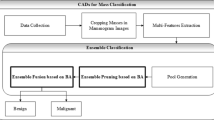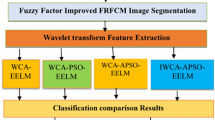Abstract
One of the most customary cancers amid women is breast cancer. Early detection of breast cancer assists in increase of survival rate. Optimal Region of Interest (ROI) extraction with ensemble classifiers directly influences diagnosis result. In this work, an ensemble classifier method called Population Rescaled Differential Evolution with Weighted Boosting (PRDE-WB) is presented. To start with, a novel ROI extraction technique depends on Logarithmic Cube-root Shift with Population Rescaled Differential Evolution Optimization is presented. Next, an Ensemble Classifier technique using Weighted Boosting is employed to improve the classification performance in turn paving way for early breast cancer detection. This method includes three main sections. The Region of Interest (ROI) is cropped according to Logarithmic Cube-root Shift Pre-processing the infra red images from breast thermal image dataset. Then ROIs are subjected to optimization technique using Population Rescaled Differential Evolution (PRDE) that obtains essential features for classification between benign and malignant masses. Finally, an ensemble classification technique using the results of the PRDE is combined with Weighted Boosting for early breast cancer detection. Numerical experiments and comparisons on a set of well-known state-of-the-art methods indicates that the PRDE-WB method outperforms and is superior to other existing methods in terms of Peak Signal-to Noise Ratio, overall classification accuracy, early breast cancer detection rate and early breast cancer detection time.







Similar content being viewed by others
References
Chiang T-C, Huang Y-S, Chen R-T, Huang C-S, Chang R-F (2018) Tumor detection in automated breast ultrasound using 3-D CNN and prioritized candidate aggregation. IEEE Trans Med Imaging 3-D Convolutional Neural Network – 3-D CNN
Saniei E, Setayeshi S, Akbari ME, Navid M (2016) Parameter estimation of breast tumour using dynamic neural network from thermal pattern. J Adv Res 7:1045–1055. Elsevier, (Inverse Thermal Modeling)
Motlagh MH, Jannesari M, Aboulkheyr HR, Khosravi P, Elemento O, Totonchi M, Hajirasouliha I Breast cancer histopathological image classification: a deep learning approach. IEEE Xplore, No 2016
Wang H, Zheng B, Yoon SW, Ko HS (2017) A support vector machine-based ensemble algorithm for breast cancer diagnosis. Eur J Oper Res. Elsevier
Kool M, Bastiaannet E, Van de Velde CJH, Marang-van de Mheen PJ (2018) Reliability of self-reported treatment data by patients with breast cancer compared with medical record data. Clinical Breast Cancer 18:234–238. Elsevier
Nahid A-A, Kong Y (2017) Involvement of machine learning for breast cancer image classification: a survey. Computational and Mathematical Methods in Medicine 2017:1–29. Hindawi
Khan MM, Mendes A, Chalup SK (2018) Evolutionary wavelet neural Networkensembles for breast cancer and Parkinson's disease prediction. PLoS One. https://doi.org/10.1371/journal.pone.0192192
Zhang Y, Guo C, Wang B, Li X (2018) A novel ensemble method for k -nearest neighbour. Pattern Recogn. Elsevier
Esener II, Ergin S, Yuksel T (2017) A new feature ensemble with a multistage classification scheme for breast cancer diagnosis. Journal of Healthcare Engineering. Hindawi
Thein HTT, Tun KMM (2015) An approach for breast cancer diagnosis classification using neural network. Advanced Computing: An International Journal (ACIJ) 6(1)
Xu J, Xiang L, Liu Q, Gilmore H, Wu J, Tang J, Madabhushi A (2016) Stacked sparse autoencoder (SSAE) for nuclei detection on breast cancer histopathology images. IEEE Trans Med Imaging 35:119–130
Zhang Y, Zhang B, Coenen F, Lu W (2012) Highly reliable breast cancer diagnosis with cascaded ensemble classifiers. IEEE World Congress on Computational Intelligence
Cong J, Wei B, He Y, Yin Y, Zheng Y (2017) A selective ensemble classification method combining mammography images with ultrasound images for breast cancer diagnosis. Computational and Mathematical Methods in Medicine 2017:1–7. Hindawi
Huang M-W, Chen C-W, Lin W-C, Ke S-W, Tsai C-F (2017) SVM and SVM ensembles in breast cancer prediction. PLoS One. https://doi.org/10.1371/journal.pone.0161501
Abreu PH, Santos MS, Abreu MH, Andrade B, Silva DC (2016) Predicting breast cancer recurrence using machine learning techniques: a systematic review. ACM Comput Surv 49(3):Article 52. Publication date: October 2016
Cai T, He H, Zhang W (2018) Breast cancer diagnosis using imbalanced learning and ensemble method. Applied and Computational Mathematics 7(3):146–154. ACM
Platania R, Shams S, Yang S, Zhang J, Lee K, Park S-J Automated breast cancer diagnosis using deep learning and region of interest detection (BC-DROID). In: ACM-BCB’17, August 20–23, 2017, Boston, MA, USA
Wang J, Ding H, Bidgoli FA, Zhou B, Iribarren C, Molloi S, Baldi P (2017) Detecting cardiovascular disease from mammograms with deep learning. IEEE Trans Med Imaging 36(5):1172–1181
Kallenberg M, Petersen K, Nielsen M, Ng AY, Diao P, Igel C, Vachon CM, Holland K, Winkel RR, Karssemeijer N, Lillholm M (2016) Unsupervised deep learning applied to breast densitysegmentation and mammographic risk scoring. IEEE Trans Med Imaging 35(5):1322–1331
Krawczyk B, Galar M, Jelenc L, Herrera F (2016) Evolutionary under sampling boosting for imbalanced classification of breast cancer malignancy. Appl Soft Comput 38:714–726
Turki T, Wei Z (2018) Boosting support vector machines for cancer discrimination tasks. Comput Biol Med 101:236–249
Saad G, Khadour A, Kanafani Q (2016) ANN and Adaboost application for automatic detection of micro calcifications in breast cancer. Egypt J Radiol Nucl Med 47:1803–1814
Vo DM (2019) Classification of breast cancer histology images using incremental boosting convolution networks. Inf Sci 482:123–138
Kozegar E, Soryani M, Behnam H, Salamati M, Tan T (2017) Breast cancer detection in automated 3D breast ultrasound using iso-contours and cascaded RUSBoosts. Ultrasonics 79:68–80
Breast Thermography Image dataset: https://www.dropbox.com/s/c7gfp2bo1ae466m/database.zip?dl=0
Author information
Authors and Affiliations
Corresponding author
Additional information
Publisher’s Note
Springer Nature remains neutral with regard to jurisdictional claims in published maps and institutional affiliations.
Rights and permissions
About this article
Cite this article
Jeyanthi, K., Mangai, S. Ensembled Population Rescaled Differential Evolution with Weighted Boosting for Early Breast Cancer Detection. Mobile Netw Appl 24, 1778–1792 (2019). https://doi.org/10.1007/s11036-019-01383-8
Published:
Issue Date:
DOI: https://doi.org/10.1007/s11036-019-01383-8




